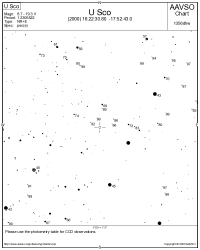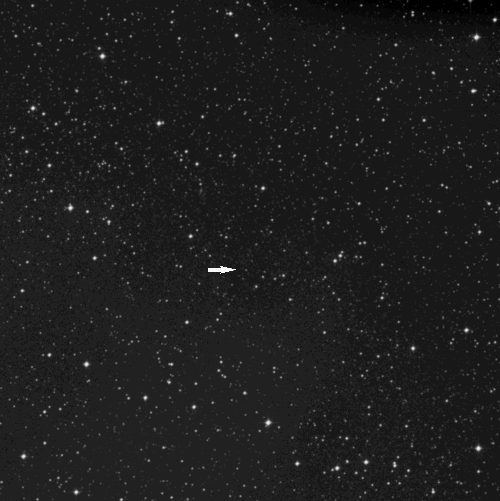Further to AAVSO Alert Notice 367 and Special Notices 127 and 141, the AAVSO requests twilight observations of the recurrent nova U Scorpii prior to its solar conjunction in late 2009. These observations are in support of the long-term campaign by Dr. Bradley Schaefer (LSU) to catch this very fast nova during its rise.
AAVSO Special Notice #171: In 2008, the last ground-based observation of U Sco was made on 2008 November 2 (S. Kerr,
Glenlee, QLD, Australia). Observers are asked to do the best they can to observe U Sco as close to the Sun as possible. For this project, fainter-than observations are just as important as positive ones, and observers are asked to report all observations as promptly as possible via AAVSO WebObs.
For more information on the U Sco campaign and its science goals, please see the following URL: http://www.aavso.org/news/usco.shtml
 U Sco is located at the following (J2000) coordinates:
U Sco is located at the following (J2000) coordinates:
RA:16:22:30.80, Dec: -17:52:43.0
Charts for U Sco may be plotted using AAVSO VSP: http://www.aavso.org/observing/charts/vsp/index.html?pickname=U%20Sco
(AAVSO Special Notice was prepared by M. Templeton)
Located north of Antares, U Scorpii is one of the most famous recurrent novae… and one of the fastest known. Able to shoot up to 8 or 9 magnitudes in less than 6 hours, dedicated observers are predicting that 2009 should see this cataclysmic variable star erupt with a vengeance. “I’ve calculated that the recurrent nova U Scorpii, north of Antares and east of the head of Scorpius, should explode any month now.” says Bradley E. Schaefer of Sky & Telescope, “My ‘crystal ball’ is based on old archival photographs and data from amateur astronomers. This brings a golden opportunity for amateurs and professionals to catch the early hours of a nova eruption and to prepare in advance for an intensive observing campaign.”
While professional observatories and NASA’s Swift Satellite will be busy gathering information about any possible eruption, there’s more than enough room for amateur observations. While it’s great to have modern equipment and credited astronomers to capture the action, their eyes can’t watch 24/7 – and chances are good that any outburst may very well be captured by ordinary viewers working in the field. “Amateurs provided essentially the whole light curves for the last three eruptions.” says Brad, “Now, with some advance warning to allow preparations, and with a little luck, the upcoming eruption of U Sco could produce the best record of a nova outburst — of any kind — ever.”
Please promptly report all observations to the AAVSO with the name “U SCO”.

